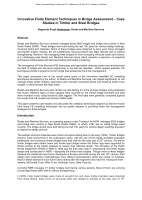Bridges

- Publication no: ABC2017-021-17
- Published: 20 April 2017
- PDF (free) Download
Roads and Maritime Services currently manages about 5600 bridges and bridge size culverts in New South Wales (NSW). These bridges were built during the last 150 years for various design loadings, structural forms and materials. Some of these bridges were designed to carry even horse carriages and traction engine vehicles, but are satisfactorily carrying present day legal vehicles with or without strengthening. However, risk managing these bridges for ever increasing vehicular loads and volume, is a challenging task Roads and Maritime Services faces which warrants a spectrum of analytical techniques substantiated with field load testing and health monitoring.
The emergence of Finite Element (FE) techniques and associated computer power has revolutionized the field of bridge and structural engineering in the last two decades. When applied judicially, FE techniques provide a powerful tool for bridge load assessment and risk management.
This paper discusses how in the recent years some of the innovative simplified FE modelling techniques developed by the author, at Roads and Maritime Services, has helped significantly to risk manage timber girder bridges, steel beam with concrete composite decks and historical timber truss bridges, to allow present day legal loads.
Roads and Maritime Services also carried out load testing for some of these bridges using dedicated test trucks. Different types of strain gauges were mounted on the critical bridge members and data were recorded in-situ using electronic data loggers. The field data were generally compared against the results from FE models and ambient traffic loads.
This paper presents case studies and discusses the validation techniques adopted so that the results from these FE modelling techniques can be quality assured in providing wider risk management strategies for these bridges.
